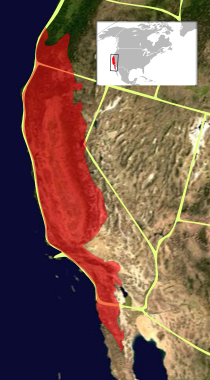California Floristic Province

The California Floristic Province (CFP) is a
The California Floristic Province belongs to the
With an area of 293,803 km2 (113,438 sq mi), as defined by
The California Floristic Province is a world biodiversity hotspot as defined by
Climate and topography
The California Floristic Province is one of the five biodiversity hotspots with
In California, the province includes most of the state excluding the Modoc Plateau, Great Basin and deserts in the southeastern part of the state. In Oregon, the province includes the coastal mountains south of Cape Blanco and most of the Rogue River watershed.[6]
In Baja California, the province includes the
In Nevada, the CFP includes the region of the Sierra in the vicinity of Lake Tahoe, with the eastern border with the Great Basin corresponding roughly to the location of Reno-Carson City.
Parts of the following mountain ranges are included in the province:
- The Klamath Mountains
- The Cascade Range
- The Coast Ranges
- The Sierra Nevada
- The Transverse Ranges
- The Peninsular ranges south into Baja California
The
California plant communities
Numerous plant communities exist in California and botanists have attempted to structure them into identifiable vegetation types groupings. Robert Ornduff and colleagues Phyllis M. Faber and Todd Keeler-Wolf did much work on this problem, and in the 2003 Natural History Guide Introduction to California Plant Life [citation needed] established a cohesive set of titles to identify California plant communities based on but somewhat different from those earlier established by California botanist Philip A. Munz.
Broken into three large groupings based on geography, the Ornduff scheme includes [citation needed]: the Cismontane ("this side of the mountain") west of the
Cismontane region
- Coastal Strand(same in Munz)
- Coastal Prairie (same in Munz)
- Coastal Salt Marsh (same in Munz)
- Chaparral (Hard Chaparral) (same in Munz)
- Closed-Cone Pine Forest(same in Munz)
- Coastal Sage Scrub(Soft Chaparral) (same in Munz)
- Freshwater marsh (same in Munz)
- Maritime Coast Range Ponderosa Pine forests
- Montane Chaparral (not in Munz)
- North Coastal Forest(includes North Coastal Coniferous Forest, Redwood Forest, Douglas-fir Forest and Mixed Evergreen Forest (from Munz) )
- Northern Coastal Scrub(same in Munz)
- Riparian Woodland (same in Munz)
- Foothill Woodland(includes Northern, Southern Oak Woodland, Foothill Woodland)
- Valley Grassland(same in Munz)
Montane region
- Montane Coniferous Forest (Yellow Pine in Munz)
- Montane Chaparral (not in Munz)
- Subalpine Forest (Red Fir Forest, Lodgepole Pine Forest, Bristlecone Pine and Subalpine Forest)
- Montane Meadow (not in Munz)
- Alpine Fell-field(same in Munz)
Transmontane region
- Pinyon-Juniper Woodland (Includes Northern Juniper Woodland, Pinyon-Juniper Woodland (both in Munz))
- Sagebrush Scrub (same in Munz)
- Shadscale Scrub (same in Munz)
- Alkali Sink Scrub(same in Munz)
- Joshua Tree Woodland (same in Munz)
- Creosote Bush Woodland(same in Munz)
Endemic species and ecosystems
The hotspot presents a higher level of endemism in plants than in animals. Of the 7,031 vascular plants (species, subspecies or varieties) found in the hotspot, 2,153 taxa (in 25 genera) are endemic, meaning they are found nowhere else.[7] About 80,000 km2, or 24.7% of the original vegetation remains in relatively pristine conditions today.
The six largest plant families in California by number of species (40% of all species of vascular plants) are:[citation needed]
The province notably has
A few examples of plants that are endemic to the province and are also endangered species are:
- Baker's larkspur
- Gowen cypress
- Hickman's potentilla
- Point Reyes bird's beak
- Santa Cruz tarplant
- Santa Rosa Island manzanita
Threatened and endangered
Agriculture and urban expansion are encroaching upon remaining
Conservation efforts
Biodiversity hotspots face the highest threats due to the fact that their resources and animal or plant species cannot be replicated or found in any other regions on the planet. Conservation efforts receive little to no funding to put toward the protection of these extremely distinctive hotspots. So establishing priorities on where to focus efforts is essential. In 1988, British Ecologist,
See also
References
- ^ "Conservation International". Conservation.org. Retrieved 5 December 2012.
- Madroño, 63:3-206.
- ^ Thorne, Robert F. Phytogeography of North America North of Mexico Archived 2004-03-17 at the Wayback Machine. Flora of North America, Vol. 1, Ch. 6.
- ^ a b c "HOTSPOT:California on the Edge". Calacademy.org. Archived from the original on 2012-12-02. Retrieved 5 December 2012.
- ^ "Tree Removal Melbourne – Tree Surgery Melbourne – Professional Tree Care Services". Tree-care.com.au. Retrieved 15 October 2017.
- ^ Tree Removal. Tree, Seed and Land Co. 2014. Retrieved 2 April 2014.
- ^ Hickman, J.C. (Ed.), 1993. The Jepson Manual, Higher Plants of California. University of California Press. Appendix I, Pg. 1315.
Further reading
- Ornduff, R., Faber, P. M. & Keeler-Wolf, T. 2003. Introduction to California Plant Life. Revised edition. University of California Press
- California Floristic Province, Smithsonian National Museum of Natural History
- California Floristic Province, Biodiversity Hotspots, Conservation International
